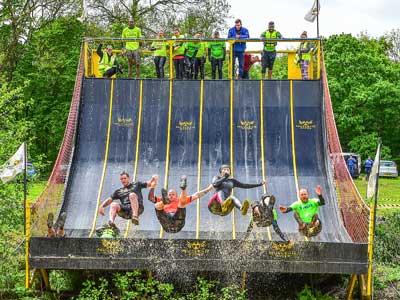Award Winning Obstacles

Voted Best Value Event

Last Saturday on a rainy November day in a muddy field in Essex, history was made. Nuclear Races hosted the first UK OCR Championships and this wasn’t merely the first one in the UK. We can be very proud that we witnessed the first independent national championships of obstacle course racing anywhere in the WORLD. As it was hosted at Nuclear Races, where many of us have raced countless times, I think a lot of people could be forgiven for being complacent beforehand… as if they knew what to expect. One of the things that impressed me on Saturday was that it was like no other Nuclear Race. I’d actually say it felt like no other race I’ve ever experienced before in the UK.
Here’s a partial GoPro edit of the course from Tom Littlewood before we go on: CLICK HERE
The Obstacle Course Racing Association (OCRA UK) who were leading the UK Championships had been working very hard with the team at Nuclear to create quite a few new obstacles. Many of which required a fair bit of upper body strength and/or technique to complete; notables were:
All of these new obstacles were tough, but achievable under normal conditions to anybody with relatively good upper body strength and technique. Under race conditions it was a different story though.
The format for both the day race (Blast) and the night race (Blackout) is the same, you have 2 hours from your start time to complete as many laps of the 5km course as you can (or want to). I lined up at 1pm for Blast, listened to the race briefing, jumped around in the warm up and then, with a bang, two jets of flames shot up into the air and we were off, down a gentle slope, over some low plastic covered hay bails, down a steep bank, into some woodland and through a container.
The course contained walls with a slight overhang, mud, The Back Scratcher: a net suspended over some tarpaulin with water being sprayed over the top of it which you have to lay underneath and pull yourself through on your back using the net, mud, ditches to jump across or clamber through, mud, a tall wooden slatted wall, mud, The Rack: hay bails to climb up, with bars the other side to slide down then into a muddy ditch and more mud.

With the wristband factor, it added a serious psychological pressure onto every single obstacle that made me take a pause before each one to think about my strategy before attempting it. It’s not purely the fact that you have to stop to do it again which loses you time. It’s also the wasted energy. If you throw yourself at an obstacle and use what feels like all of your strength to make it 80% of the way only to slip… Your brain wants to tell you that in your current condition – you can’t do any better.
This whole added pressure and excitement of the wristband factor was amplified ten times by the weather. Not only was it raining and so all of the obstacles were slippery, but also it was cold which was sapping a lot of racers’ strength and losing fingertip control. Many people who would be able to complete certain obstacles with no problem in the dry and warm were having extra difficulties.
The thing I loved so much about it was that it created scenes of emotion and determination that we don’t often see in the sport and we almost never see it amongst the front runners.
The moment of the day for me was undoubtedly watching Freya Martin on the Ring Traverse. She was in first place and had a good lead on Dita in second, but after making incredibly rapid progress through the course she came to a surprising halt at the Ring Traverse. I don’t know if it was the wet rings that were causing her hands to slip off or the fact that she had run so hard for the first 14km, but she was really struggling. After the first three or four attempts we could see a panic start to set in her eyes because for her, if she couldn’t get across, it wasn’t just ‘the wristband’ at stake and the pride that goes with it… It was the championship title and cash prize. The whole crowd was behind her, shouting support and the marshalls and OCRA adjudicators there were fantastic, sticking with her the whole way. After the fifth time falling off I heard her say to one of her teammates that she didn’t think she’d get across but she took a couple of minutes out to take a breather, she shook off her arms and refused to give up
When she came back and tried again, with the crowd making a huge noise for her, she made it to the end and her screams of relief and joy as she got to the other end were a wonder to behold and definitely the most emotion I’ve ever seen during an obstacle race. Luckily, Mudstacle TV were there to catch every second so you can see it for yourself below: CLICK HERE
But Freya wasn’t the only person to become stuck on these rings. Dave Peters –
the Energise Mud Runners coach spent a whole hour there but also refused to give up and eventually completed it to finish the race with wristband still complete – albeit in a much slower time than he was probably expecting. I saw several other racers (all very fit guys and very strong obstacle racers) look close to tears as they fell time and time again. It was heart-breaking to watch but really inspiring at the same time. Even James Appleton, multiple Tough Guy champion and previous winner of the Mudstacle league dropped from it twice, but thankfully made it across on the third attempt and had enough of a lead over Ross Brackley that he kept his second place position for the rest of the race (despite Ross nailing it first time).
For me, it was the tip of the spear obstacle that nearly stopped me in my tracks. After the first waves had been through, the grippy paint had entirely wiped off, leaving only a very slippery surface. For my first five attempts I got nowhere and just slid unceremoniously back to where I started. But I stuck with it and, guided by Chris Boardman (the OCRA adjudicator who was there), I successfully developed a ‘leap and skip’ technique to get across on the 7th or 8th attempt. Big thanks to Chris for seeing me across there.
There was debate beforehand as to whether the course was looking ‘too upper body tough’ and therefore unrepresentative of the UK OCR scene. My own take on this now is that, whilst I firmly believe you don’t NEED technically challenging obstacles to create world class courses (just look at Nuts or Tough Guy), having them certainly added another dimension to the race. It created a theatre of emotions the likes of which we’ve not previously seen in our fledgling sport.
This race really had it all. The whole thing from start to finish was worthy of a peak audience televised event – from the pipe band and explosive pyrotechnic start to the phenomenally varied course featuring 86 man-made obstacles, more mud than you’d care to shake a stick at, regular ditches, ponds, rivers and plenty of running in between all made up the 10 mile course that was truly worthy of making history.
Before I end a couple of people deserve some recognition and thanks from the community. Firstly to James Parrish and his team at Nuclear Races. There is no doubt that the race would not have been the race it was without the huge investment that they put in to making it a success. Nuclear don’t do things by halves so we always knew they’d put on a good show but I think they surpassed all expectations.
And finally of course, to all of OCRA UK and in particular Mark Leinster who only took over ownership of the championships three months before race day,
threw his body and soul into it and worked tirelessly in a manner of which few people are capable of. Without Mark’s efforts the UK championships would not have had much differentiation from the Nuclear Fallout – he took it from a great race to an outstanding competition.
Representatives were there from the Obstacle Course Race Associations in Benelux, France, Spain, Germany and Italy and once again we can be proud that the UK are the showing the rest of the world the way.

The rules were outlined beforehand and all racers knew the deal… A green wristband was attached to every runner with their race number written on it. Every obstacle on the course had to be completed successfully. If at any point on any obstacle the runner slips, trips, falls or completes the obstacle by an unauthorised method then they have to go back and do it again. They can take as many attempts as they want, but completion is mandatory. If they choose to continue without completing the obstacle then they ask the adjudicator to cut the wristband from their arm. Those people who complete the course without their wristband still get a time, but are put on a separate list to those who completed the whole thing successfully and will get a 4 minute penalty per failed obstacle.
The ‘wristband rule’ was first introduced to us at the World Championships two years ago and it gets talked about a lot, but this was the first time it had been implemented in a UK race. This was my first experience of it and I have to say that I loved it!
On a normal race I’d have a go at something like a set of hang tough rings knowing that sometimes I complete them and sometimes I don’t. If this time turns out to be an occasion that I don’t make it across then I’d simply shrug my shoulders and say ‘oh well!’ then proceed to either run on, do my burpees, press ups or additional running penalty and not think twice about it.